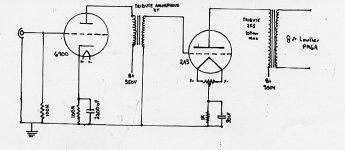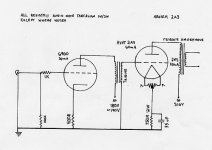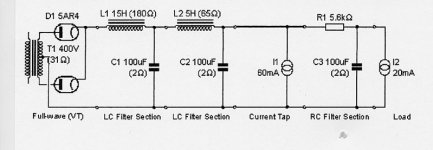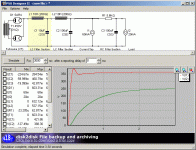Hello,
I'm looking to build the ultimate 2A3 amplifier for my Lowther PM6As in medallion cabinets. I've selected the 6900 version of the 417A triode as the input (due to it's high plate voltage) and an interstage coupled design. This is my first time drawing a tube schematic so the resistor and capacitor values are basically made up, please help me with what will work! I know how to build the PS, I will be using a 5AR4 regulator and AC filaments.
Let me know what you think.
I'm looking to build the ultimate 2A3 amplifier for my Lowther PM6As in medallion cabinets. I've selected the 6900 version of the 417A triode as the input (due to it's high plate voltage) and an interstage coupled design. This is my first time drawing a tube schematic so the resistor and capacitor values are basically made up, please help me with what will work! I know how to build the PS, I will be using a 5AR4 regulator and AC filaments.
Let me know what you think.
Attachments
Certainly looks good, could be an absolute killer judging the parts you'll be using. Proper PS needed of course.
One small point: with the high-gm tube such as the 6900, a grid resistor should not be omitted. I'd opt for 1kOhm, mounted directly to the tube socket. The 2A3, when not driven into A2, might like one as well (100 ohms or so).
Regards,
Remco
One small point: with the high-gm tube such as the 6900, a grid resistor should not be omitted. I'd opt for 1kOhm, mounted directly to the tube socket. The 2A3, when not driven into A2, might like one as well (100 ohms or so).
Regards,
Remco
Excuse the shortness of my reply, but, I only stopped in for a moment whilst waiting for a download and saw this post.
1: there is no such thing as an ultimate amplifier. I am constantly amazed by the variation in how different designs sound when playing into a real reactive load. But it and tweak the sound until you love it.
2: 2A3: B+ is a bit high. About 300V on the plate, say 310 at the top of the transformer. Aiming for 250V plate to cathode, -45V bias, Rk =750R and Ik = 60mA. This is a well known and used design point and apparently sounds excellent. Whether it is the best for you or not I dunno, but it will be close. Tweak from there.
3: If you adopt the operating point I mentioned, the Tribute transformer will be a fraction short on current capacity. With 60mA as a centre, you really need double that for full power. Check the specs on the transformer. Some are underrated a little deilberately yo allow some adjustment in bias. 2k5 Zp will be fine
4: 6900 driver. I know nothing about it except that it was designed for pulse applications in weapons etc. Supposed to be good, but the data I have <a href="http://frank.nostalgiaair.org/sheets/131/6/6900.pdf">from here</a> is sketchy on audio applications. From a quick look at the curves I'm WAGing Vp=180V, Ik=20mA, Vg=-8V, Rk=400R. Should swing 150Vp-p, about 3 x what you need. Good, linear and lots of headroom. You need to decide on a bias for the 6900 so you can have the IT gapped correctly.
5: PSU: Full wave tube rectified, LC -> OPT -> RC -> 6900. I'd use a good shunt regulator too. Try Lundahl LL1673/20H PSU chokes.
6: Driver filament: AC, use CT transformer and bias filaments to 40V above ground.
7: Grid Rs: As ultranalog said, grid R of 100-1000R on grid of 6900, soldered with almost no lead, none if possible, right at the socket. Low power metal film or carbon comp. 2A3 shouldn't need one with an IT.
Gotta run
Ciao
1: there is no such thing as an ultimate amplifier. I am constantly amazed by the variation in how different designs sound when playing into a real reactive load. But it and tweak the sound until you love it.
2: 2A3: B+ is a bit high. About 300V on the plate, say 310 at the top of the transformer. Aiming for 250V plate to cathode, -45V bias, Rk =750R and Ik = 60mA. This is a well known and used design point and apparently sounds excellent. Whether it is the best for you or not I dunno, but it will be close. Tweak from there.
3: If you adopt the operating point I mentioned, the Tribute transformer will be a fraction short on current capacity. With 60mA as a centre, you really need double that for full power. Check the specs on the transformer. Some are underrated a little deilberately yo allow some adjustment in bias. 2k5 Zp will be fine
4: 6900 driver. I know nothing about it except that it was designed for pulse applications in weapons etc. Supposed to be good, but the data I have <a href="http://frank.nostalgiaair.org/sheets/131/6/6900.pdf">from here</a> is sketchy on audio applications. From a quick look at the curves I'm WAGing Vp=180V, Ik=20mA, Vg=-8V, Rk=400R. Should swing 150Vp-p, about 3 x what you need. Good, linear and lots of headroom. You need to decide on a bias for the 6900 so you can have the IT gapped correctly.
5: PSU: Full wave tube rectified, LC -> OPT -> RC -> 6900. I'd use a good shunt regulator too. Try Lundahl LL1673/20H PSU chokes.
6: Driver filament: AC, use CT transformer and bias filaments to 40V above ground.
7: Grid Rs: As ultranalog said, grid R of 100-1000R on grid of 6900, soldered with almost no lead, none if possible, right at the socket. Low power metal film or carbon comp. 2A3 shouldn't need one with an IT.
Gotta run
Ciao
Forgot.
- Cathode bypass on 2A3: I like em big, say 100u PP, no crappy electros.
- Cathode bypass on 6900. Get rid of it. they sound awful.
- PSU caps should be PP or PP/oil
- 6900's are really expensive and a bit hard to get. There are alternatives like ECC99, 6H30, 6c45 (if you really need the gain), 7119, 7044 etc. If you have them, great use em.
- Cathode bypass on 2A3: I like em big, say 100u PP, no crappy electros.
- Cathode bypass on 6900. Get rid of it. they sound awful.
- PSU caps should be PP or PP/oil
- 6900's are really expensive and a bit hard to get. There are alternatives like ECC99, 6H30, 6c45 (if you really need the gain), 7119, 7044 etc. If you have them, great use em.
Re: choke/cap input
Regards,
Remco
Choke input. Definitely. Better regulation, less peak current draws from the rectifier (read: less HF from rectifier). Smaller caps needed. PSU will be cleaner; the amp will sound more open and relaxed.Which do you guys prefer sonically, choke or cap input?
Regards,
Remco
PSU
Aaron,
You won't find me arguing with Ultranalog that easily.
So,that's a choke input from me too.
Dunno about Gordon Rankin, but Sakuma and Kondo seem to have a taste for the overly soft,suave kind of presentation of sound.
Matter of cuisine,I'ld say.
You're "ze chef".
Cheers,
Aaron,
You won't find me arguing with Ultranalog that easily.
So,that's a choke input from me too.
Dunno about Gordon Rankin, but Sakuma and Kondo seem to have a taste for the overly soft,suave kind of presentation of sound.
Matter of cuisine,I'ld say.
You're "ze chef".
Cheers,
psu
Choke input it is! Now, the power supply for the B+ and the A+, B+ is taken at 60mA (~320V), A+ is taken at 20mA (~190V)
Transformer is the Tango MX-175. Chokes are the Tango LC-5-250D and the Tango LC-15-150D cut-cores.
The first two caps you see will be Black Gate WKZ. The third cap has to be Elna Cerafine unless I win the lottery.
How's it look?
Choke input it is! Now, the power supply for the B+ and the A+, B+ is taken at 60mA (~320V), A+ is taken at 20mA (~190V)
Transformer is the Tango MX-175. Chokes are the Tango LC-5-250D and the Tango LC-15-150D cut-cores.
The first two caps you see will be Black Gate WKZ. The third cap has to be Elna Cerafine unless I win the lottery.
How's it look?
Attachments
Hey Aaron,
Supply looks pretty good. I ran it through PSUD and found that I got 210V for the driver. Upping the series R to 6700 put it spot on 190V.
I also tried stepping the load on both current sources to half and double the quiescent values, and it was stable, so a big signal input won't send it into wild oscillations.
If you haven't bought the Blackgates yet, don't, find some PP in oil metal can caps or some Solens in similar or larger values. Will probably be cheaper than the BGs and maybe even the Elnas. PP PSU caps are much nicer sounding. To my ears there seems to be a drop in the background hash, and a general increase in resolution I have difficulty describing.
Also, if you haven't bought the chokes yet, look into the Lundahls. They are exceptional and very cheap for the quality. All 4 should be around $US250 in the States. Just checked at www.kandkaudio.com and they're $US66 ea. I'd get 4 x LL1673/15H . I have some of these and the 20H versions as well and I'm very pleased with them. Only negative is they're not pretty, but they are small so you can mount under the top plate.
I'd recommend the Lundahls for the OPTs as well.
Cheers
Brett
Supply looks pretty good. I ran it through PSUD and found that I got 210V for the driver. Upping the series R to 6700 put it spot on 190V.
I also tried stepping the load on both current sources to half and double the quiescent values, and it was stable, so a big signal input won't send it into wild oscillations.
If you haven't bought the Blackgates yet, don't, find some PP in oil metal can caps or some Solens in similar or larger values. Will probably be cheaper than the BGs and maybe even the Elnas. PP PSU caps are much nicer sounding. To my ears there seems to be a drop in the background hash, and a general increase in resolution I have difficulty describing.
Also, if you haven't bought the chokes yet, look into the Lundahls. They are exceptional and very cheap for the quality. All 4 should be around $US250 in the States. Just checked at www.kandkaudio.com and they're $US66 ea. I'd get 4 x LL1673/15H . I have some of these and the 20H versions as well and I'm very pleased with them. Only negative is they're not pretty, but they are small so you can mount under the top plate.
I'd recommend the Lundahls for the OPTs as well.
Cheers
Brett
Strange, that schematic came straight from PSU designer..
Anyway, I'll look for the PP in oil caps. The Solens would actually be cheaper then the Black Gates.
Finally, I like Tango iron. I would use a Tamura F-5001 as the output transformer, but I have heard the Tribute is just as good, and is half the price. I believe the Lundahl would be a compromise in this area.
Anyway, I'll look for the PP in oil caps. The Solens would actually be cheaper then the Black Gates.
Finally, I like Tango iron. I would use a Tamura F-5001 as the output transformer, but I have heard the Tribute is just as good, and is half the price. I believe the Lundahl would be a compromise in this area.
Re: psu
Well, not bad for starters, but I would like to point out a few things:
I try to avoid using same LC values in subsequent sections to avoid ringing and motorboating. Simulating with PSUD, at the start you already see about a 10 Hz ringing, which corresponds to the L and C used. Furthermore, I'd use small C's up front and larger C's to the back. This reduces rectifier peak currents again. And after all, it's only the last C that feeds the amplifier. The voltage after the first choke is determined by the tranny and the choke, changing C does nearly nothing for voltage there.
I raised chokes to 10H. Usually these have a little more DCR, which is good to dampen the LC response. I try to aim for critical dampening (Q=0.5, 4% overshoot).
Here's a pic of the sim. I've stepped up the tranny voltage a bit.
The 5k6 in the voltage line is a tad high, but if you bias the driver deep into class A it won't matter too much. Still I prefer separate driver stage supplies, I find it reduces intermodulation distortion a lot, which gives you that open, seemingly effortless sound.
Regards,
Remco
How's it look?
Well, not bad for starters, but I would like to point out a few things:
I try to avoid using same LC values in subsequent sections to avoid ringing and motorboating. Simulating with PSUD, at the start you already see about a 10 Hz ringing, which corresponds to the L and C used. Furthermore, I'd use small C's up front and larger C's to the back. This reduces rectifier peak currents again. And after all, it's only the last C that feeds the amplifier. The voltage after the first choke is determined by the tranny and the choke, changing C does nearly nothing for voltage there.
I raised chokes to 10H. Usually these have a little more DCR, which is good to dampen the LC response. I try to aim for critical dampening (Q=0.5, 4% overshoot).
Here's a pic of the sim. I've stepped up the tranny voltage a bit.
The 5k6 in the voltage line is a tad high, but if you bias the driver deep into class A it won't matter too much. Still I prefer separate driver stage supplies, I find it reduces intermodulation distortion a lot, which gives you that open, seemingly effortless sound.
Regards,
Remco
Attachments
Aaron,
6900 is a HIQ version of the 5687, not of the 417A.
both 417A and even more 437A have higher transconductance. They may be tricky to tame in this application. And as both have way higher µ, your bias will be maybe too low and you have no headroom for the input swing.
Can sound good, can sound awful.
The 6900 if properly applied is one of the best tubes for audio. Sonically.
You have a µ of 18, bias should be somewhere between -7 and minus 12.5 V, depending whether your plate voltage is rather 180 or 250V.
I would choose the 6900. No Q.
6900 is a HIQ version of the 5687, not of the 417A.
both 417A and even more 437A have higher transconductance. They may be tricky to tame in this application. And as both have way higher µ, your bias will be maybe too low and you have no headroom for the input swing.
Can sound good, can sound awful.
The 6900 if properly applied is one of the best tubes for audio. Sonically.
You have a µ of 18, bias should be somewhere between -7 and minus 12.5 V, depending whether your plate voltage is rather 180 or 250V.
I would choose the 6900. No Q.
Look for the Bendix 6900...
I used 5687 on my 2A3 amp. I am still sourcing for this Bendix 6900... Any body knows the sonic signature for this tube on a 2A3 SET amp?
The monoplate RCA 2A3 is the best recommended! Balloon 45's are eyecathing and with depths.
I would be glad to know the listening impressions you have with this amp...
Thank You and Good Luck,
John
I used 5687 on my 2A3 amp. I am still sourcing for this Bendix 6900... Any body knows the sonic signature for this tube on a 2A3 SET amp?
The monoplate RCA 2A3 is the best recommended! Balloon 45's are eyecathing and with depths.
I would be glad to know the listening impressions you have with this amp...
Thank You and Good Luck,
John
- Status
- This old topic is closed. If you want to reopen this topic, contact a moderator using the "Report Post" button.
- Home
- Amplifiers
- Tubes / Valves
- Check my first design, 6900/2A3 IT



